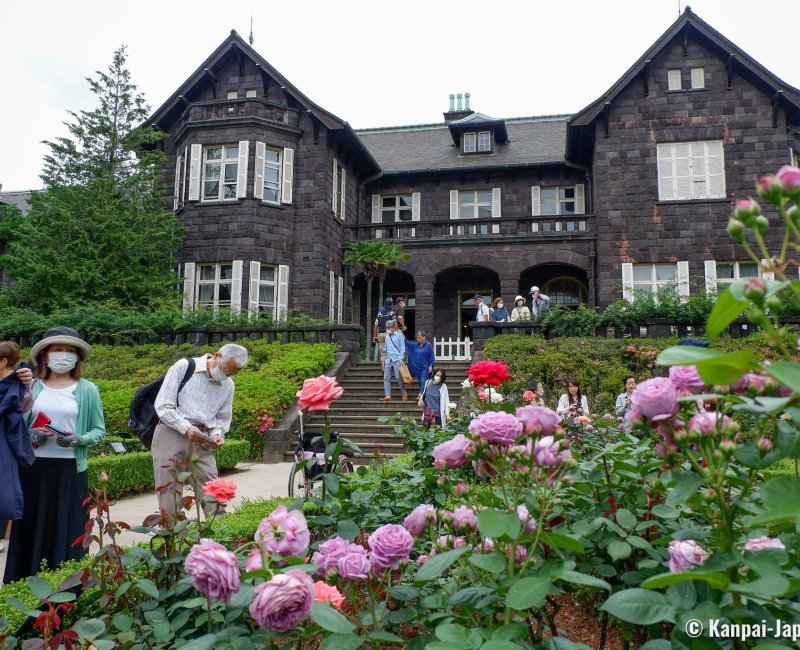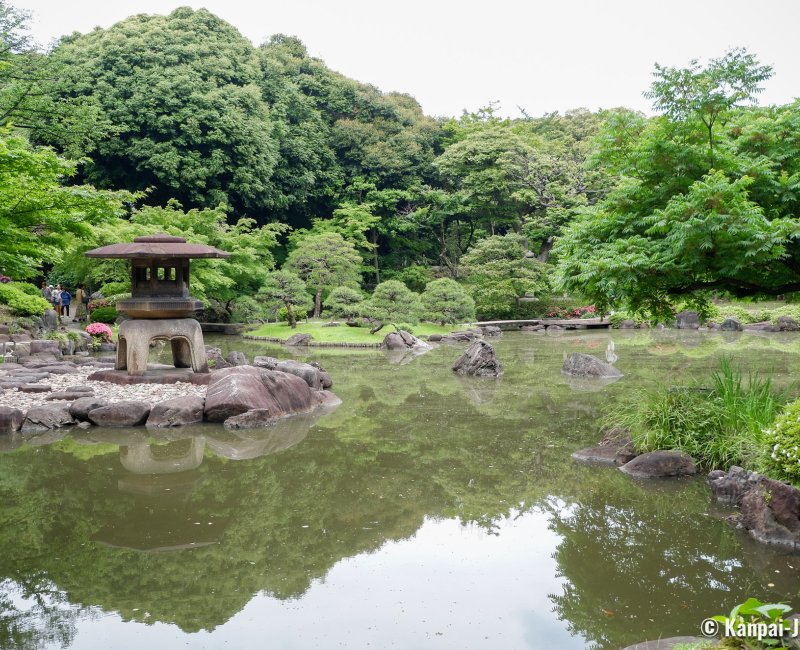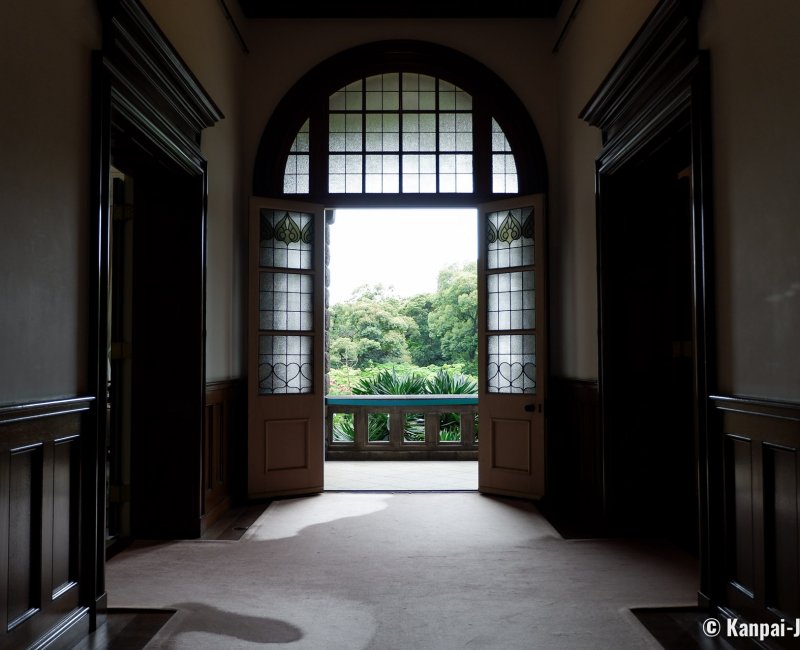Kyu Furukawa Teien
🌹 The Rose Garden in the North of Tokyo
Kyu Furukawa Teien is a set of Western-style and Japanese-style gardens built around the former home of the Furukawa family, located in the north of Tokyo in Japan. This historical property is displaying a modern architecture typical of the Taisho Era. It can be visited in spring and in autumn, to enjoy the blooming of the rose garden and the colors of the Japanese maple trees.
In the north of Tokyo, near Oji, the quiet Nishigara neighborhood is home to one of the 9 Japanese gardens managed by Tokyo Metropolitan Government and also the lesser known among international tourists: Kyu Furukawa Teien. The site encompasses an old residence consisting of a Western-style architecture mansion dating back to the early 20th century adjoined with 2 separate green spaces: a rose 🌹 garden and a traditional Japanese stroll garden.
This historical estate is particularly enjoyable when the roses bloom, which happens twice a year:
- In spring 🌸, usually between mid-May to June; then,
- In autumn 🍁, between mid-October to late November.
Planted on a slanted landscape, the rose blossoms cascade in front of the main building, offering a fragrant and colorful scenery both ephemeral and elegant. The queen of the flowers is represented in its various hues, from red, rose, violet to orange or white. Each rose variety is marked by a sign, allowing for a fun game trying to identify the "Catherine Deneuve" rose or the roses named after the princesses of the Japanese imperial family for example. The rose shrubberies are arranged in a Western-style garden, with narrow paths and geometrically-shaped plants.

The 2 blooming seasons of the roses attract a lot of Japanese people in Kyu Furukawa Teien, and especially elderly visitors who tend to prefer going in the morning. Thus, a short waiting line is likely to form at the entrance booth, as, at the time of writing, the admission ticket is only purchasable at the door. We recommend going in early afternoon on a weekday to avoid the crowd and have enough time to take pictures (note that tripods are prohibited).
The souvenir shop is supplied with seasonal items, such as jams, enhanced with rose perfume. In the background, maple foliage heighten the view on the flowers with their lovely green leaves in spring and their bright red hues in autumn.
However Kyu Furukawa Teien is not limited to its rose garden and the whole estate is worth the visit, being a rare example of a preserved architectural and historical heritage in Tokyo. The former residence of the Furukawas was designated a National Cultural Property and Place of Scenic Beauty and has maintained its appearance of the early days of the Taisho Era (1912 - 1926).

Historical site of the early 20th century’s Taisho Era
Extending on the Musashino plateau, the land was initially owned by Mutsu Munemitsu (1844 - 1897), a statesman and diplomat of the early Meiji Era. The property was transferred to the Furukawas after they adopted Munemitsu’s 2nd son Junkichi (1870 – 1905), who thereafter becomes the 2nd head of the Furukawa family. Around 1904, Toranosuke Furukawa (1887 - 1940) extends the property to build the main family home.
He then relied on the skills of 2 personalities that were trendy at the times in Japan:
- British architect Josiah Conder (1852 – 1920), also foreign advisor in Japan, and later nicknamed the "father of Japanese modern architecture", who designed the main building as well as the Western-style garden, which were completed in May 1917.
- Kyoto’s gardener Jihei Ogawa VII (1860 – 1933), in charge of designing a Japanese stroll garden around a pond, Shinji-ike, whose shape is inspired by Japanese character 心 kokoro (meaning "heart") in 1919.
While its look of an English house may surprise in the heart of Tokyo, the residence harmoniously combines the Western and Japanese styles. The facades are built in Shin-Komatsu-ishi (andesite) a type of volcanic rock originating from Manazuru in the north-east of the Izu Peninsula. The ground floor is dedicated to reception rooms with a Western-style decoration, and the upper floor has a Japanese layout with traditional rooms, including the bedrooms.
The gardens of Kyu Furukawa Teien opened to the public in April 1956 and has been operated by the Metropolitan Government of Tokyo ever since. The former Furukawa residence was converted into a museum only in 1989, which is called the "Otani Art Museum" and offers an additional depth to the visit while illustrating a later part of the estate’s history.

Otani Art Museum
The Art Museum was named after Yonetaro Otani (1881 - 1968) a businessman particularly successful in the steel and hospitality industries. He notably founded the New Otani Tokyo luxury hotel 🏨 in Akasaka in 1964. As a friend and business partner of the Furukawas in the early 20th century, he reclaimed their former residence after the war and expressed his wish to make it a place to display his personal art collection someday.
The Furukawa House was requisitioned by the occupation forces at the end of World War II to use it as a dormitory. While it was not damaged by the air raids, its architecture did deteriorate due to the lack of maintenance over time. Therefore, several years of renovation works were necessary before the Otani Art Museum finally opened in 1989.
The museum is home to temporary exhibitions, mainly focusing on ukiyo-e prints of the museum’s private collection and on Conder’s architecture. The building also has a "Coffee House," a coffee shop installed in the former dining room, and accessible during the opening hours to all visitors of Kyu Furukawa Teien Gardens.
Lastly, another style of museum is available in the area: the Earthquake Science Museum located in Kita ward’s Disaster Prevention Center, near Takinogawa Park and Kami-Nakazato JR station.

